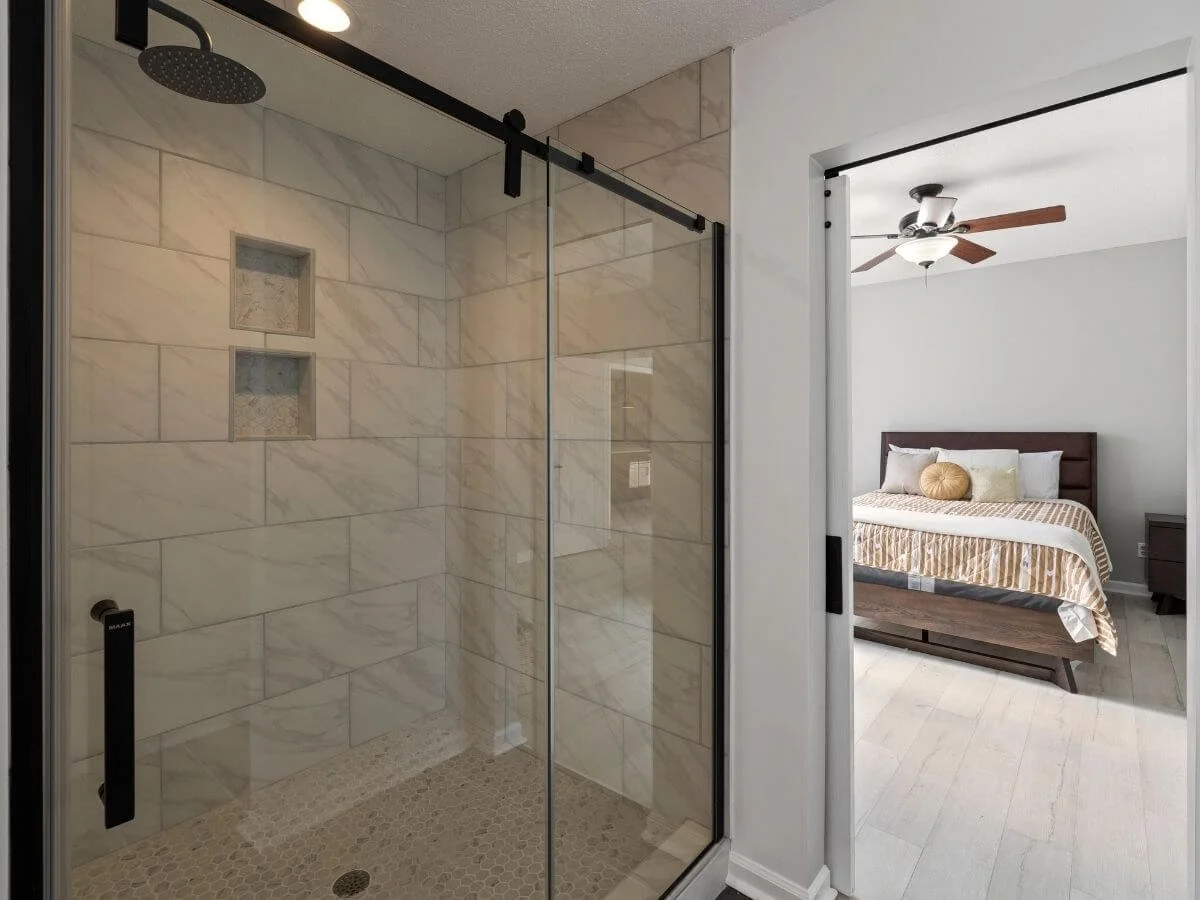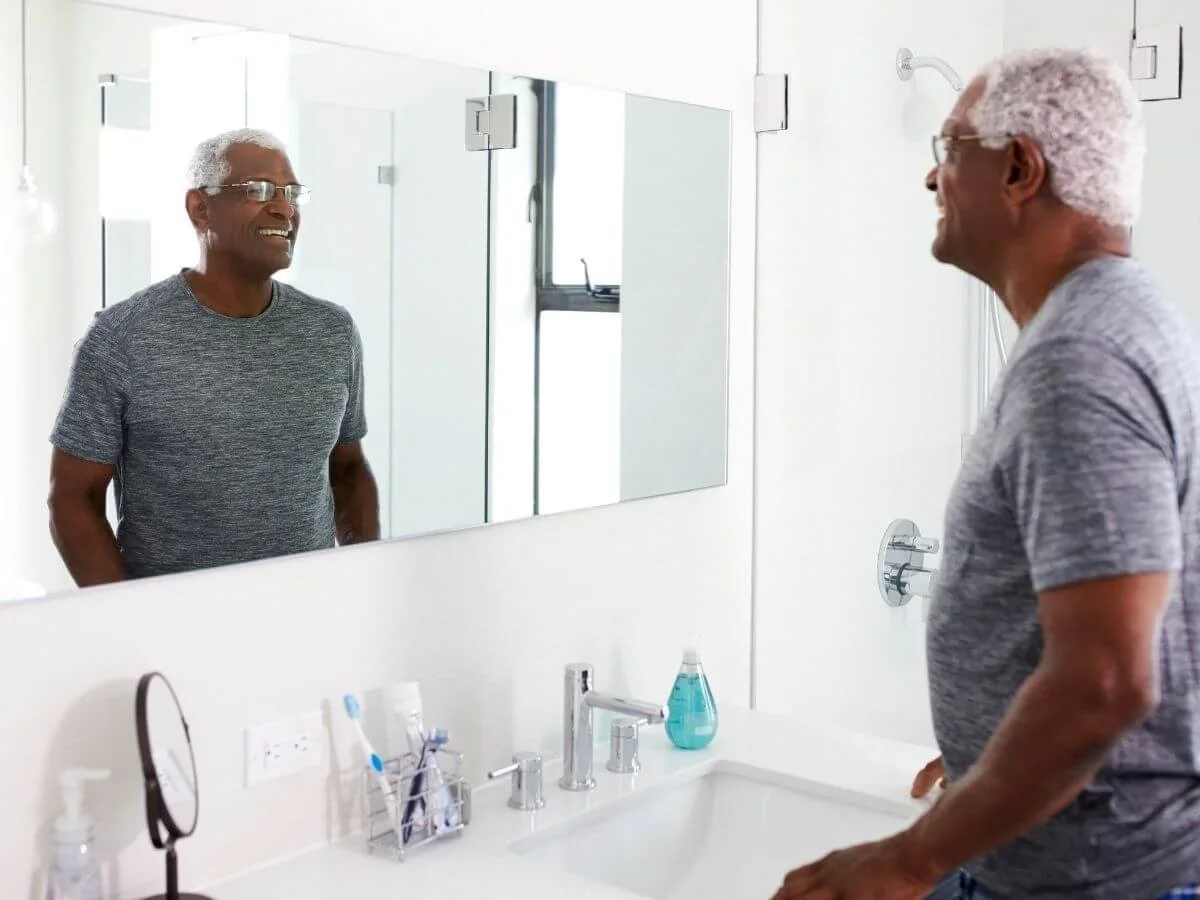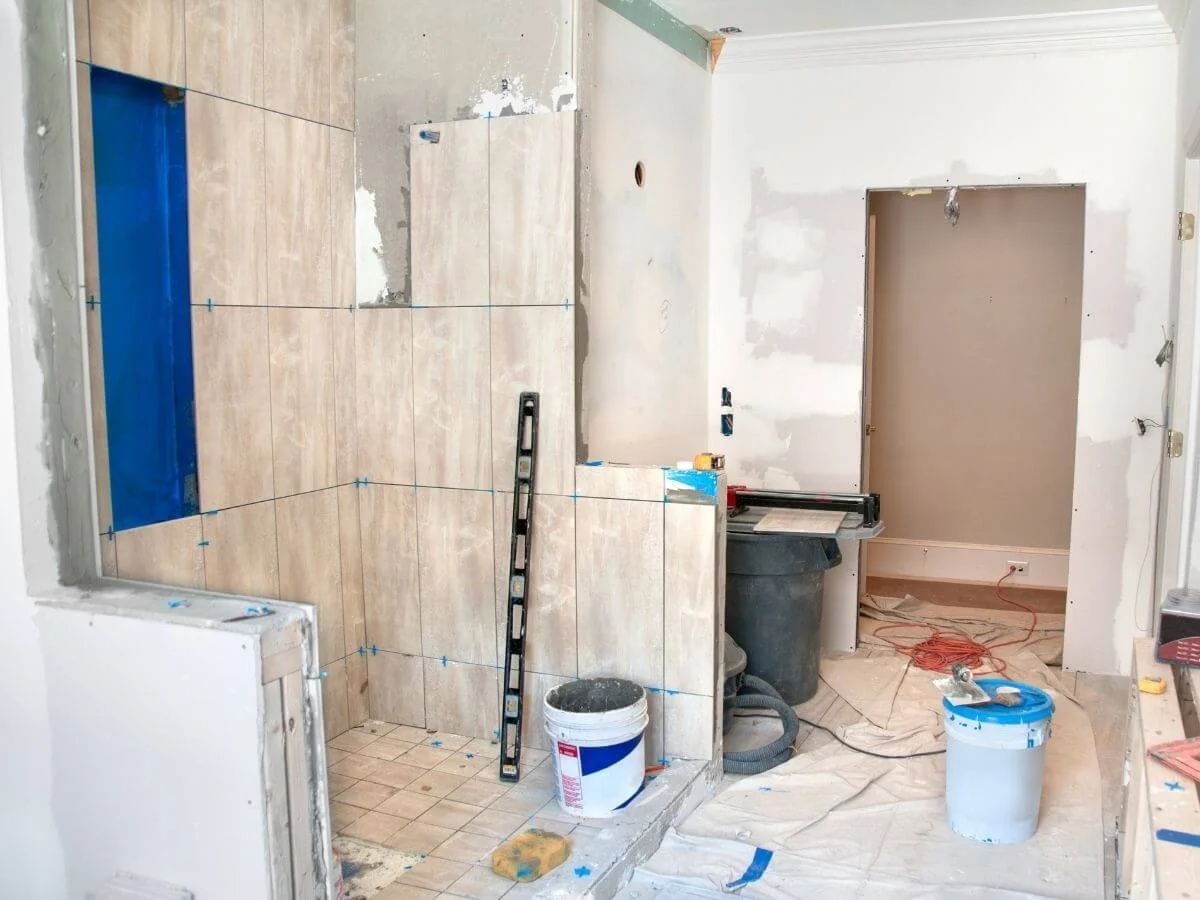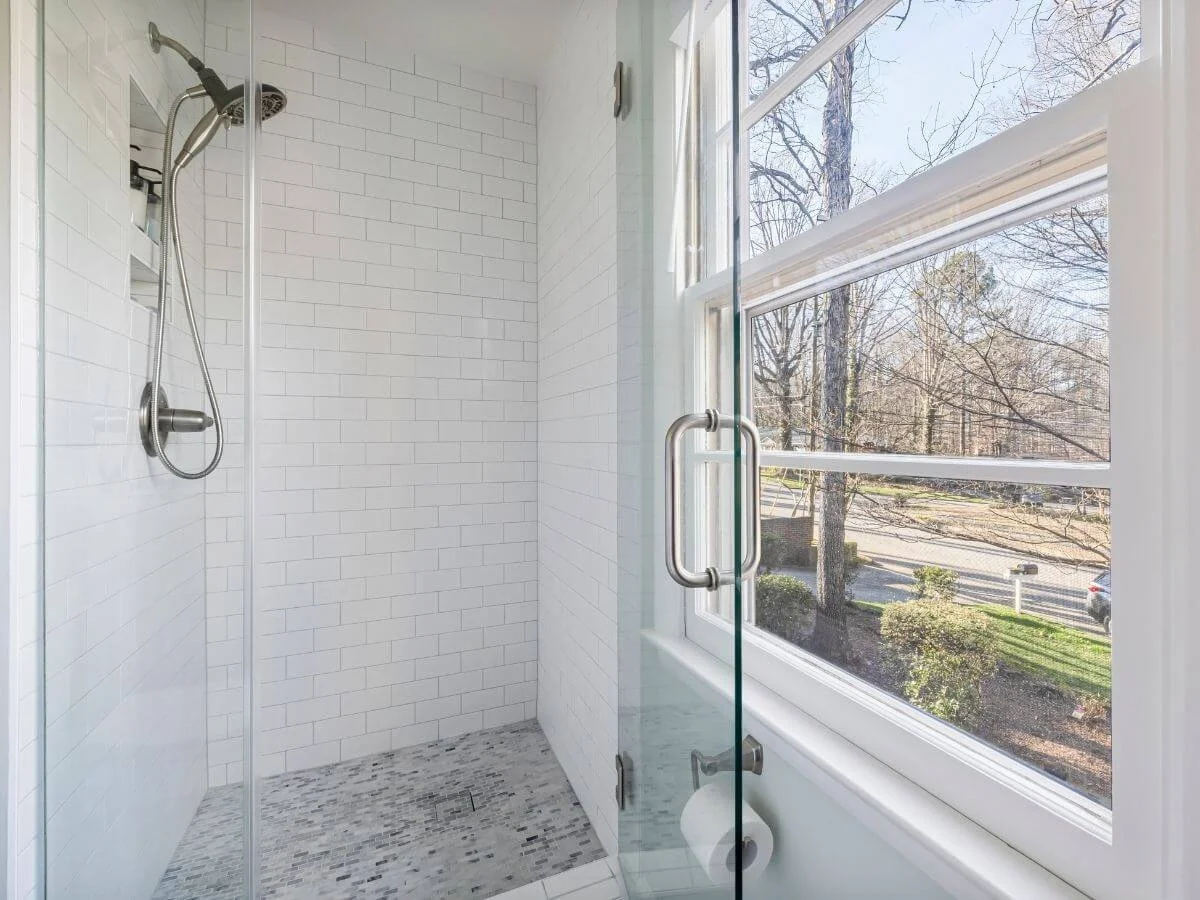Are Walk-In Showers a Good Investment? (Pros, Cons, ROI & Bath Renovation Guide)
Thinking about installing a walk-in shower but worried about the cons of a walk-in shower or how it affects home value? This guide explains how the right upgrade can add value to your bath space and to your renovation budget overall. You’ll learn what drives real-world returns, where the pitfalls are, and how to decide if this project fits your goals.
What is a walk-in shower—and why are they increasingly popular bath renovation options?
A walk-in shower is a curbless or low-threshold shower with open entry, often enclosed with glass. Unlike traditional enclosures, it maximizes appeal and functionality and makes smaller bathroom footprints feel more spacious. Walk-in showers have become a favorite bathroom upgrade because they’re versatile, modern, and straightforward to clean.
Many walk-in showers offer design flexibility—tile from floor to ceiling, linear drains, multiple shower heads, and benches—creating a spa-like atmosphere that looks sleek without crowding the room.
How does a walk-in shower impact home value and ROI?
For most households, the key question is return on investment (ROI). A well-executed project can boost property value by improving aesthetic appeal, functionality, and buyer confidence. While exact numbers vary by region and scope, homeowners typically see solid value when the shower is part of a smart bathroom remodel that aligns with local comps and a home’s price tier. Think “value and appeal,” not just “new tile.”
A realistic view of roi weighs cost, quality, and market norms. In a strong real estate market, an updated bathroom with a walk-in can help your home feel move-in ready, which can make your home more marketable and support a higher sale price.
Pros of a walk-in shower: What buyers and owners love
The biggest pros of a walk-in shower revolve around design freedom and everyday comfort. Open glass and modern lines amplify light; continuous tile makes cleaning easier; and frameless doors remove visual clutter. For many, the shower experience becomes more relaxing—some even describe it as a spa-like experience.
From a resale perspective, buyers looking for move-in-ready homes notice updated baths. A fresh walk-in shower might be the detail that differentiates a listing, especially in competitive neighborhoods.
What are the cons of a walk-in shower?
Every project has trade-offs. The key cons of a walk-in shower include potential water splash if the opening is too wide, warmth retention in colder climates, and less privacy for shared bath spaces. The phrase cons of walk-in often points to poor planning, not the concept itself: undersized glass, weak ventilation, or a drain slope that wasn’t set correctly.
Remember that the cons of walk-in showers can be minimized with proper shower installation, thoughtful glass layout, and appropriate fixtures.
Do you need to keep a tub for resale value?
If you have multiple baths, keeping at least one tub or bathtub can broaden appeal to families with young kids. In a one-bath home, replacing the only bathtub with a shower can narrow your buyer pool. Balance lifestyle and resale: one luxurious walk-in and one traditional tub works well in many markets.
Accessibility, mobility, and aging in place: Who benefits most?
Because of the low threshold, a walk-in improves accessibility for anyone with limited mobility or mobility issues. Add grab bars and a bench for safer daily routines and aging in place. Walk-ins can make the home feel like a forever home, supporting independence without sacrificing style—another reason walk-in showers provide meaningful quality-of-life upgrades beyond simple looks.
Aesthetics and modern shower design: Why do walk-ins look so good vs a traditional shower?
Open glass, continuous tile, and clean lines suit modern design trends. The right shower design creates a sense of luxury with minimal visual barriers. When executed well, it’s both low-maintenance and beautiful, striking a balance of aesthetics and function that outperforms many conventional showers.
Cost vs. value: What should homeowners expect to spend?
Every project boils down to cost vs benefit. Price depends on demo, plumbing adjustments, glass, waterproofing, and finishes. A reputable remodeling company will specify membranes, slope, and drainage to protect your structure. Pairing durable materials with timeless finishes delivers the best long-term home improvement value.
When aligned with neighborhood expectations, adding a walk-in can be a wise investment that supports the value of a home over time.
Shower installation tips: How to avoid common mistakes
Proper shower installation prevents leaks and splash. Ensure correct floor pitch toward the drain, adequate ventilation, and a glass opening sized to contain spray. Curbless entries require meticulous waterproofing—hire a vetted pro for this home improvement project.
If you prefer a simpler path, a traditional shower installation with a small curb still achieves much of the look at a lower cost while preserving performance.
Bathroom remodel strategy: Where does a walk-in fit?
Treat the walk-in as the anchor of a cohesive bathroom remodel. Coordinate fixtures, lighting, and ventilation so the whole bathroom feels intentional. A modest home remodel that refreshes surfaces and adds a glass enclosure can transform an older bath into a new bathroom without over-spending.
If you’re adding a walk-in shower as part of a larger bathroom renovation, keep finishes neutral; those choices appeal to more buyers and protect your home’s value.
Will a walk-in shower add value to your home for resale?
In many markets, including walk-in showers boosts perceived quality. Paired with timeless finishes, they can add value by signaling recent work and reducing buyer “project fatigue.” While not every update guarantees a dollar-for-dollar return, walk-ins often help listings photograph better, attract more showings, and ultimately sell your home faster.
If your city publishes a value report for remodeling, compare typical returns. Your contractor can also reference neighborhood comps to align scope with expected resale value.
Is a walk-in shower worth the investment for small spaces?
Absolutely—small spaces benefit from glass and open entry. Eliminating a bulky tub deck reclaims visual width, and a linear drain with continuous tile expands sightlines. In tight footprints, a walk-in can feel like an addition to your home without moving a wall.
How to choose finishes that balance durability, style and aesthetic appeal
Prioritize waterproofing first, then finishes. Use high-quality membranes behind tile, specify durable grout, and pick a fixture set that fits your water pressure and maintenance preferences. Clear glass maximizes light; textured glass adds privacy. Aim for neutral tones with one accent so the aesthetic appeal lasts through trends.
From plan to project: Steps for homeowners
Define goals: accessibility, look, or resale.
Get two or three bids from a licensed remodeling company.
Confirm waterproofing details and glass specs.
Choose timeless finishes and practical shower heads.
Schedule and protect adjacent rooms during demo.
With the right plan, walk-in showers include all the function you need while maintaining a refined look.
What do appraisers and buyers notice most?
Appraisers consider age and condition of major rooms. Fresh, neutral updates in the bathroom suggest good maintenance. For homebuyer psychology, professional photos of a bright walk-in and coordinated vanity create instant value and appeal. That’s how walk-in showers make a difference at listing time.
Frequently asked questions about ROI, design, and installation
-
Not if there’s another full bath with a bathtub elsewhere in the home. Keep one tub to satisfy family buyers, and let your primary bathroom showcase the walk-in as a focal point.
-
Quality waterproofing, proportionate scope for the neighborhood, and timeless finishes. These factors boost return on investment while keeping roi steady in different market cycles.
-
Size the opening carefully, angle the spray away from the door, pitch the floor correctly, and include adequate ventilation. Good glass geometry beats over-large openings.
-
Yes—just verify structure and plumbing. Curbless shower installation may require subfloor modifications; a low curb is a flexible compromise.
Putting it all together: Is a walk-in shower a good investment?
If you value a brighter, easier-to-clean bathroom with modern lines, a walk-in shower can be worth the investment. Done right, it elevates daily life and can strengthen your home’s market position. For many households—the design-forward, the accessibility-minded, and those planning to sell your home within a few years—this upgrade strikes the right balance of utility and long-term value.
Quick glossary of project paths
Installing a walk-in shower as a stand-alone update: fastest route to visual impact.
Full remodel with coordinated vanity, lighting, and ventilation: best for aging finishes.
Hybrid approach: replace enclosure and tile, keep layout and plumbing.
Key takeaways
A walk-in shower can lift home value when aligned with neighborhood expectations and smart design.
Plan for accessibility with grab bars and thoughtful layout to support aging in place while maintaining a spa-like look.
Keep at least one tub in the home for broad buyer appeal; avoid removing the only bathtub.
Prioritize waterproofing, correct floor slope, and right-sized glass for durability and comfort.
Choose neutral finishes and quality fixtures to protect resale value and maximize return on investment.
Work with a reputable remodeling company; a professional bathroom plan helps ensure the project is a wise investment.
Bottom line: When thoughtfully designed and properly installed, a walk-in shower is a practical, beautiful bathroom upgrade that enhances daily living and can add measurable value to your home—making it a standout choice for your next renovation.








